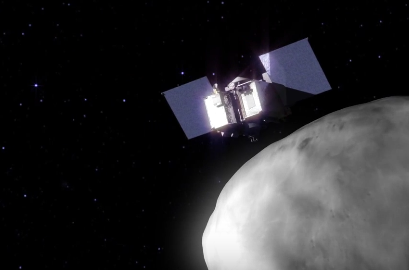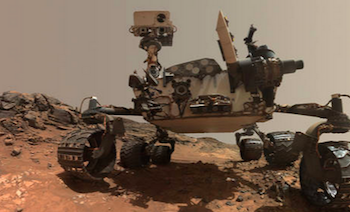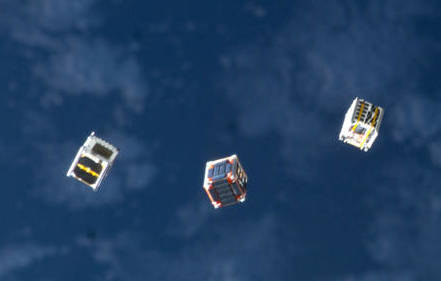Intergalacticnerd - Space N Shit

More Posts from Intergalacticnerd and Others

In this Chandra image of NGC6388, researchers have found evidence that a white dwarf star may have ripped apart a planet as it came too close. When a star reaches its white dwarf stage, nearly all of the material from the star is packed inside a radius one hundredth that of the original star.

A photo of Saturn. Took by Cassini with COISS on May 30, 2008 at 11:52:37. Detail page on OPUS database.

A photo of Jupiter. Took by Voyager with VGISS on February 01, 1979 at 23:13:23. Detail page on OPUS database.

Psychedelic Pluto : New Horizons scientists made this false color image of Pluto using a technique called principal component analysis to highlight the many subtle color differences between Plutos distinct regions.
js

Ultraviolet Coverage of the Hubble Ultra Deep Field
js
The Shakespearean Moons of Uranus
This weekend marks the 400th anniversary of Shakespeare’s death, and we’re highlighting the moons of Uranus; some of which are named after characters from his works.

While most of the moons orbiting other planets take their names from Greek mythology, Uranus’ moons are unique in bing named for Shakespearean characters, along with a couple of them being named for characters from the works of Alexander Pope.

Using the Hubble Space Telescope and improved ground-based telescopes, astronomers have discovered a total of 27 known moons around Uranus.
Here’s a sampling of some of the unique aspects of the moons:
Miranda

Shakespearean work: The Tempest
Miranda, the innermost and smallest of the five major satellites, has a surface unlike any other moon that’s been seen. It has a giant fault canyon as much as 12 times as deep as the Grand Canyon, terraced layers and surfaces that appear very old, and others that look much younger.
Ariel

Shakespearean work: The Tempest
Ariel has the brightest and possibly the youngest surface among all the moons of Uranus. It has a few large craters and many small ones, indicating that fairly recent low-impact collisions wiped out the large craters that would have been left by much earlier, bigger strikes. Intersecting valleys pitted with craters scars its surface.
Oberon

Shakespearean work: A Midsummer Night’s Dream
Oberon, the outermost of the five major moons, is old, heavily cratered and shows little signs of internal activity. Unidentified dark material appears on the floors of many of its craters.
Cordelia and Ophelia

Shakespearean works: Cordelia - King Lear; Ophelia - Hamlet
Cordelia and Ophelia are shepherd moons that keep Uranus’ thin, outermost “epsilon” ring well defined.
Between them and miranda is a swarm of eight small satellites unlike any other system of planetary moons. This region is so crowded that astronomers don’t yet understand how the little moons have managed to avoid crashing into each other. They may be shepherds for the planet’s 10 narrow rings, and scientists think there must be still more moons, interior to any known, to confine the edges of the inner rings.
Want to learn more about all of Uranus’s moons? Visit: http://solarsystem.nasa.gov/planets/uranus/moons
Check out THIS blog from our Chief Scientist Ellen Stofan, where she reflects on the life and legacy of William Shakespeare on the 400th anniversary of his death on April 23, 1616.
Make sure to follow us on Tumblr for your regular dose of space: http://nasa.tumblr.com
Solar System: 2016 Preview
What do we have planned for 2016? A return to the king of planets. A survey of mysterious Ceres. More postcards from Pluto. Anyone who follows solar system exploration in 2016 is in for quite a ride. Last year was one for the record books – and now here are 10 things to look forward to in the new year. See also: what we have planned agency wide for 2016.
Juno Arrives at Jupiter

July 4, 2016 is arrival day for the Juno mission, the first sent expressly to study the largest planet in the solar system since our Galileo mission in the 1990s. Humans have been studying Jupiter for hundreds of years, yet many basic questions about the gas world remain: How did it form? What is its internal structure? Exactly how does it generate its vast magnetic field? What can it tell us about the formation of other planets inside and outside our solar system? Beginning in July, we’ll be a little closer to the answers.
OSIRIS-REx Takes Flight

The OSIRIS-REx mission, short for Origins-Spectral Interpretation-Resource Identification-Security-Regolith Explorer, sets sail for an asteroid in September. The spacecraft will use a robotic arm to pluck samples from the asteroid Bennu to help better explain our solar system’s formation and even find clues to how life began.
Dawn Sees Ceres Up Close

After an odyssey of many years and millions of miles, in December the Dawn spacecraft entered its final, lowest mapping orbit around the dwarf planet Ceres. The intriguing world’s odd mountains, craters and salty deposits are ready for their close-ups. We can expect new images of the starkly beautiful surface for months.
Cassini Commences Its Grand Finale

In late 2016, the Cassini spacecraft will begin a daring set of orbits called the Grand Finale, which will be in some ways like a whole new mission. Beginning this year and extending into next, the spacecraft will repeatedly climb high above Saturn’s poles, flying just outside its narrow F ring 20 times. After a last targeted Titan flyby, the spacecraft will then dive between Saturn’s uppermost atmosphere and its innermost ring 22 times. As Cassini plunges past Saturn, the spacecraft will collect rich and valuable information far beyond the mission’s original plan.
New Horizons Sends More Postcards from Pluto

We have stared slack-jawed at the images and discoveries from last year’s Pluto flyby, but the fact is that most of the data that New Horizons collected remains on board the spacecraft. In 2016, we’ll see a steady release of new pictures — and very likely some expanded answers to longstanding questions.
Mars Missions March Forward

With five of our missions continuing their Martian quests, 2016 should be a good year for discoveries on the Red Planet.
Mars Odyssey
Mars Opportunity
Mars Reconnaissance Orbiter
Mars Curiosity
MAVEN
Mercury Transits the Sun

A transit is a very rare astronomical event in which a planet passes across the face of the sun. In May, Mercury will transit the sun, on of only thirteen Mercury transits each century on average.
LRO Keeps an Eagle Eye On the Moon

The Lunar Reconnaissance Orbiter (LRO) will extend its run in 2016, scanning the moon’s surface with its sharp-eyed instruments, investigating everything from lava tube skylights to changes at the Apollo landing sites.
Spacecraft Fly Under Many Flags

Our partner agencies around the world will be flying several new or continuing planetary missions to destinations across the solar system:
Akatsuki at Venus
ExoMars
Mars Express
Mars Orbiter Mission
Rosetta at Comet 67/P
Technology Demonstration Missions Push the Envelope

We’re always looking for new frontiers on distant worlds, as well as the technology that will take us there. This year, several missions are planned to take new ideas for a spin in space:
Deep Space Atomic Clock
NODES
LDSD
Make sure to follow us on Tumblr for your regular dose of space: http://nasa.tumblr.com


It was just discovered that there is a large ocean of water deep within the surface of Saturn’s icy moon, Enceladus.

Dying star IC 4406
js



Highest point in Georgia
-
 creepiinitreaal reblogged this · 4 months ago
creepiinitreaal reblogged this · 4 months ago -
 westcityup reblogged this · 4 months ago
westcityup reblogged this · 4 months ago -
 westcityup liked this · 4 months ago
westcityup liked this · 4 months ago -
 carrotzoo liked this · 4 months ago
carrotzoo liked this · 4 months ago -
 shealreadydecided reblogged this · 4 months ago
shealreadydecided reblogged this · 4 months ago -
 unsuccessor reblogged this · 5 months ago
unsuccessor reblogged this · 5 months ago -
 fag-cult liked this · 7 months ago
fag-cult liked this · 7 months ago -
 reddeadsea reblogged this · 7 months ago
reddeadsea reblogged this · 7 months ago -
 perfe5t reblogged this · 7 months ago
perfe5t reblogged this · 7 months ago -
 babayagasbottomfeeder reblogged this · 8 months ago
babayagasbottomfeeder reblogged this · 8 months ago -
 y2ksnowglobe reblogged this · 8 months ago
y2ksnowglobe reblogged this · 8 months ago -
 humanityinmotion reblogged this · 9 months ago
humanityinmotion reblogged this · 9 months ago -
 foxeseatbrekkers liked this · 1 year ago
foxeseatbrekkers liked this · 1 year ago -
 dessi1998 reblogged this · 2 years ago
dessi1998 reblogged this · 2 years ago -
 soft--dragon liked this · 2 years ago
soft--dragon liked this · 2 years ago -
 rowlets-are-seriously-round reblogged this · 2 years ago
rowlets-are-seriously-round reblogged this · 2 years ago -
 sapphicwedding liked this · 2 years ago
sapphicwedding liked this · 2 years ago -
 karinasmiley reblogged this · 2 years ago
karinasmiley reblogged this · 2 years ago -
 temple-of-floraa reblogged this · 2 years ago
temple-of-floraa reblogged this · 2 years ago -
 tsukarikata reblogged this · 2 years ago
tsukarikata reblogged this · 2 years ago -
 tsukarikata liked this · 2 years ago
tsukarikata liked this · 2 years ago -
 thedragonflycafe liked this · 2 years ago
thedragonflycafe liked this · 2 years ago -
 twizzydeville liked this · 2 years ago
twizzydeville liked this · 2 years ago -
 atypicalsadgirl reblogged this · 2 years ago
atypicalsadgirl reblogged this · 2 years ago -
 unicornpriiinc3ss liked this · 2 years ago
unicornpriiinc3ss liked this · 2 years ago
"Astronomy compels the soul to look upwards and leads us from this world to another." - Plato
147 posts